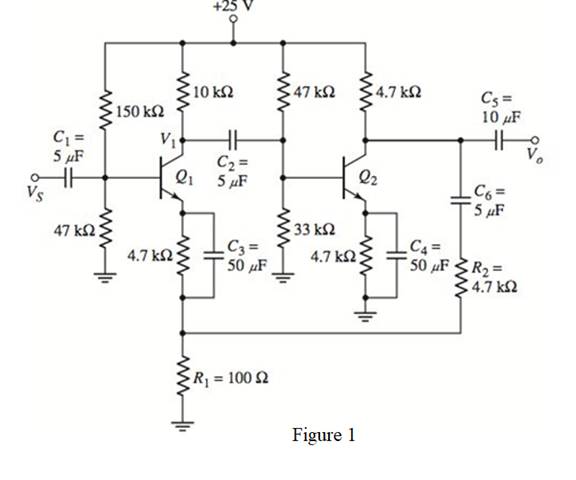
Concept explainers
The value of the closed loop small signal voltage gain at the mid band frequency.
Answer to Problem 12.42P
Thevalue of the small signal closed loop voltage gain is
Explanation of Solution
Given:
The given circuit is shown in Figure 1.

Calculation:
The Thevenin resistance of the above circuit is calculated as,
The expression to determine the value of the Thevenin voltage is given by,
The expression to determine the value of the current
Substitute
The expression to determine the value of the collector current is given by,
Substitute
The expression for the small signal input resistance is given by,
Substitute
The expression for the trans-conductance of the first transistor is given by,
Substitute
The Thevenin resistance of the second transistor is calculated as.
The expression to determine the value of the Thevenin voltage of the second transistor is given by,
The expression to determine the value of the current
Substitute
The expression to determine the value of the collector current is given by,
Substitute
The expression for the small signal input resistance is given by,
Substitute
The expression for the trans-conductance of the first transistor is given by,
Substitute
The diagram for the small signal equivalent circuit is shown in Figure 2

Figure 2
The expression to determine the value of the supply voltage is given by,
Apply KCL at node
Substitute
Substitute
Apply KCL at node 1
Substitute
Apply KCL at node 2
Substitute
Substitute
Substitute
Substitute
Conclusion:
Therefore, the value of the small signal closed loop voltage gain is
Want to see more full solutions like this?
Chapter 12 Solutions
Microelectronics: Circuit Analysis and Design
- I need proper solution for the following( underdstandable writing and well explained) thank you What is resonance in LCR circuit? and tell the difference between impedance and resistance?arrow_forward11. What is the configuration of the given amplifier circuit below?12. How are the coupling capacitors treated in the figure of #11 at AC?arrow_forwardFor the filter in the Figure shown: (a) What is the critical frequency? (b) Looking at the critical frequency formula, how would you increase the critical frequency value? (c) What is the voltage gain? (d) Looking at the voltage gain formula, how would you increase the gain?arrow_forward
- Discus the Time Response Analysis and the Frequency Response Analysis. Discuss the Bode plot and Nyquist (Polar) plot to estimate the system stability and comment.arrow_forwardAnswer the Question / What are the main disadvantages of designing the band reject filter, mentioned above? Suggest a butter circuit design.arrow_forwardThe system given in the figure ; a. Draw the signal flow chart and obtain the transfer function with the gain formula. payarrow_forward
- Explain which one is better, Frequency discriminator or Phase discriminator methods ?arrow_forwardWhat is the transfer function of a system that has poles and zeros indicated in the figure and whose gain constant is K = 4? A ? B? C? D?arrow_forwardA) Write the equation for the small-signal gain function ???????for the followingop-amp circuit B) What kind of filter is this circuit? C)Write the equation for the cutoff frequency of the filter D) Sketch the Frequency Response of the system.arrow_forward
 Introductory Circuit Analysis (13th Edition)Electrical EngineeringISBN:9780133923605Author:Robert L. BoylestadPublisher:PEARSON
Introductory Circuit Analysis (13th Edition)Electrical EngineeringISBN:9780133923605Author:Robert L. BoylestadPublisher:PEARSON Delmar's Standard Textbook Of ElectricityElectrical EngineeringISBN:9781337900348Author:Stephen L. HermanPublisher:Cengage Learning
Delmar's Standard Textbook Of ElectricityElectrical EngineeringISBN:9781337900348Author:Stephen L. HermanPublisher:Cengage Learning Programmable Logic ControllersElectrical EngineeringISBN:9780073373843Author:Frank D. PetruzellaPublisher:McGraw-Hill Education
Programmable Logic ControllersElectrical EngineeringISBN:9780073373843Author:Frank D. PetruzellaPublisher:McGraw-Hill Education Fundamentals of Electric CircuitsElectrical EngineeringISBN:9780078028229Author:Charles K Alexander, Matthew SadikuPublisher:McGraw-Hill Education
Fundamentals of Electric CircuitsElectrical EngineeringISBN:9780078028229Author:Charles K Alexander, Matthew SadikuPublisher:McGraw-Hill Education Electric Circuits. (11th Edition)Electrical EngineeringISBN:9780134746968Author:James W. Nilsson, Susan RiedelPublisher:PEARSON
Electric Circuits. (11th Edition)Electrical EngineeringISBN:9780134746968Author:James W. Nilsson, Susan RiedelPublisher:PEARSON Engineering ElectromagneticsElectrical EngineeringISBN:9780078028151Author:Hayt, William H. (william Hart), Jr, BUCK, John A.Publisher:Mcgraw-hill Education,
Engineering ElectromagneticsElectrical EngineeringISBN:9780078028151Author:Hayt, William H. (william Hart), Jr, BUCK, John A.Publisher:Mcgraw-hill Education,





